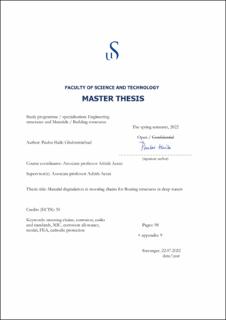| dc.description.abstract | There is a dire need for an efficient, trustworthy, and financially feasible positioning technique for offshore large floating structures. Of all the methods of positioning the offshore structures, the mooring chains play a significant role. There is a need for explicit knowledge of the properties of mooring systems so that the design, operation, and analysis of large floating structures, particularly in deep water, should be reliable. Experts from the oil and gas industry have experienced actual corrosion loss rates data for mooring systems that they get are different from those allowed for in traditional design guidance and have long been a recognized challenge. The corrosion allowances from the codes are sometimes very conservative leading to an over design (thicker); this could be the other way round, in some cases. Recently, as long as corrosion has been tolerated with an 'allowance', thicker and heavier chains have been the only way to extend the life of these mooring chains.
On the other hand, Corrosion rates can be unpredictable and vary greatly around the world due to the diverse marine environments. As a worst-case scenario, this results in significantly shortened chain lifespans and, at the very least, increased failure rates and integrity issues in the mooring systems.
The findings of this study will result in a practical equation function from previous studies that can be used to estimate corrosion loss in deep water based on parameters that have a significant impact on the corrosion, such as temperature, and dissolved inorganic nitrogen (nitrates, nitrites, and ammonia) usually measured together as DIN concentration levels. Data may be unavailable in some regions, or finding them may be difficult, and using the allowances during design from the standards without considering the parameters may lead to inappropriate allowances, and as a result failure may occur. Thereafter, estimating the rest life of inservice degraded mooring chains is another issue and how can this be done through FEM analysis. Finally, although Cathodic Protection has long been a part of corrosion prevention strategies for offshore steel structures, the mooring lines have never been successfully protected in deep waters. Finding a method of protection to extend the lifetime of these degraded chains is another challenge. Following extensive research, a new sacrificial anode cathodic protection system technology has been found in recent years. Considering this method has guaranteed efficiency and a cathodic protection calculation has been made using these anode types. | |
